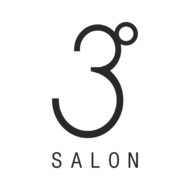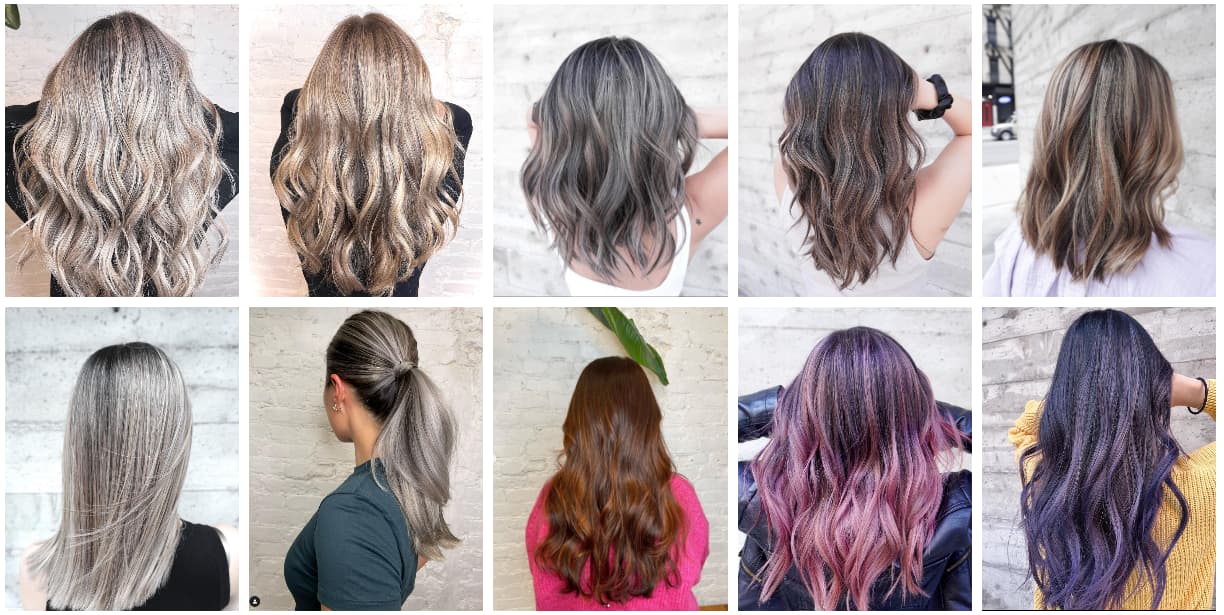Whether you have done it or not, you might have heard of this "Balayage" coloring technique if you are into hair colors.
Balayage has been a widely used hair-coloring technique and has continued to evolve over the years, with new variations and styles being developed to suit different hair types, textures, and personal preferences.
At Three Degrees Salon, Balayage is one of the most popular menus that we get requested daily from our clients with various hair types. In this article, the owner and creative director of Three Degrees Salon, Kei, explains everything you need to know about Balayage, so you know how Balayage can change your look and how to order what you want at a hair salon. We also talk about some confusion/comparison with Highlights and concerns you may have about styling, recommended maintenance period, and color-fading at Q&A.
All the hairstyle photos shown in this post are original and done by our colorists/stylists at Three Degrees Salon.
View this post on Instagram
Who wrote this article?
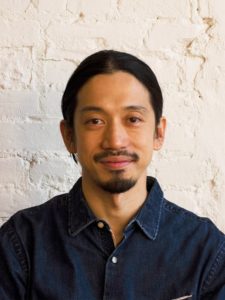
Kei Hirata
Owner/Creative Director
Three Degrees Salon
Other Popular Article:
Hair Color Guide - Read if you are unsure which menu to book
Balayage 101: The Basics to know and 8 Elegant Balayage Colors
Content
1: What is Balayage? Why is it so popular?
2: Types of Balayage
3: Who should try Balayage and what to consider before getting it?
4: Style Inspirations
1 - Balayage on Brown Hair
2 - Balayage on Black Hair
3 - Blonde Balayage
4 - Grey Pearl Balayage
5 - Caramel Balayage
6 - Chestnut Balayage
7 - Lavender Balayage
8 - Pink Balayage
5: Q&A
Q: What is the difference between Highlights vs Balayage?
Q: How should I style my Balayage hair? Should I curl my Balayage hair?
Q: How often do I need to go to a hair salon for maintenance?
Q: What are the tips to preserve hair colors?
6: Summary
1: What is Balayage? Why is it so popular?
Balayage is a hair coloring technique that involves hand-painting highlights onto the hair in a graduated, natural-looking way. The name "balayage" comes from the French word for "sweeping," which refers to the way the color is applied to the hair.Balayage has become very popular in recent years for several reasons:
1: Natural-looking results
One of the main reasons balayage has become so popular is that it creates a natural-looking, sun-kissed effect that mimics the way hair would naturally lighten in the sun. The hand-painted technique allows for a more subtle, blended look compared to other highlighting techniques, making it a great option for those who want to lighten their hair without looking overly processed.
2: Low Maintenance
Balayage requires less maintenance than other hair coloring techniques, as the grow-out is more gradual and the color is applied in a way that allows it to blend more seamlessly. This means that you can go longer between touch-ups and enjoy a low-maintenance hair color that still looks great.
3: Versatility
Balayage is a versatile technique that can be customized to suit any hair type, color, hair length, or texture.
4: Less damaging
Because balayage is hand-painted onto the hair, it is less damaging than other hair coloring techniques that require the hair to be saturated in bleach or other harsh chemicals. This makes it a great option for those who want to lighten their hair without causing too much damage.
5: Trendy
Balayage has been embraced by many celebrities and has become a popular hair trend in recent years. It is a sought-after hair coloring technique!
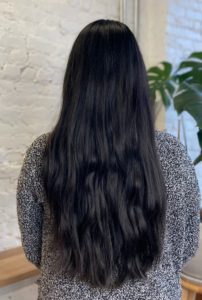
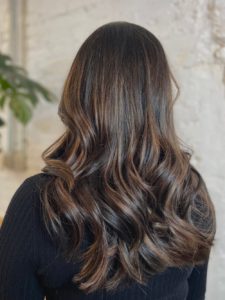
Before & After
2: Types of Balayage
There are many types of balayage techniques, but here are some key techniques that we use for our clients.Classic Balayage
This is the traditional balayage technique, where the colorist hand-paints the highlights onto the hair.
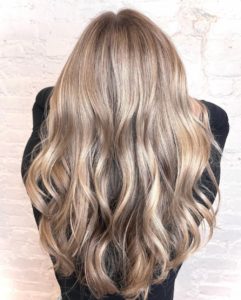

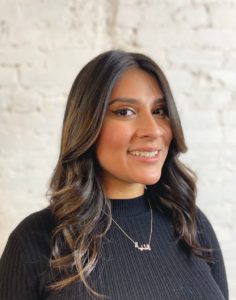
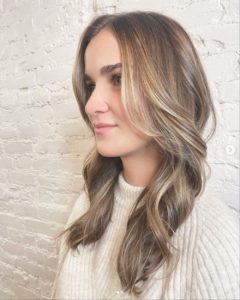
Foilyage
This is a combination of balayage and foil highlights, allowing for more control over the lightening process and creating a more dramatic, high-contrast effect.

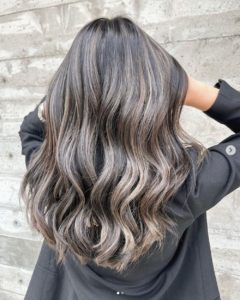
Babylights Balayage
This technique involves painting very fine, delicate highlights throughout the hair, creating a soft, natural-looking effect.
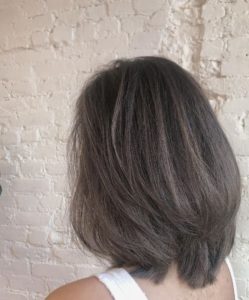

Sombre Balayage
This is a subtle, more toned-down version of ombre, with a more natural-looking gradient of color from dark to light.


Ombre Balayage
This is a technique where the colorist gradually lightens the hair from mid-lengths to ends, creating a gradient effect.


Each of these variations offers a unique twist on the traditional balayage technique, allowing for endless possibilities when it comes to creating a custom look for each client.
3: Who should try Balayage and what to consider before getting it?
If these apply to you, Balayage might be your next go-to style :-Those who want a subtle, natural-looking color
-Those with naturally dark hair who want to add dimension and depth
-Those with medium to long hair
-Those who want to color with a lower maintenance
Balayage can be a great option for many different people, but it is particularly well-suited for those who want a low-maintenance, natural-looking hair color that adds dimension and depth to their hair without going for a full head of highlights.
It's important to team up with a skilled and experienced stylist/colorist who can create a customized balayage look that's perfect for you. They're like your hair's best friend, helping you pick the right color and technique that matches your hair type, skin tone, and your unique style. Plus, they will guide you on how to keep your hair looking fabulous with a simple hair care routine.
4: Style Inspirations
In this chapter, we have chosen the best 7 Balayage colors – they have been either very popular and/or our stylists’ favorite trending colors. Check out these gorgeous hair color ideas done by Three Degrees Salon's skillful stylists/colorists.1 - Balayage on Brown Hair
Balayage has a great fit for brown hair. Brown hair can benefit from balayage in many ways, including adding dimension, softening harsh lines, and enhancing texture.It can be also customized to suit a wide range of brown hair shades, from light brown to dark brown. Your colorist should be able to work with you to achieve the perfect shade and placement of highlights to suit your face shape and style.


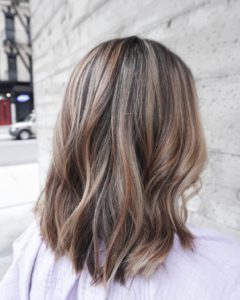
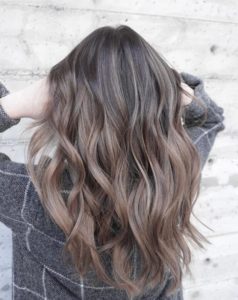
2 - Balayage on Black Hair
The effect of Balayage on black hair can be more dramatic or subtle depending on the brightness of the highlight/balayage.If your hair is black/virgin hair, it may require more intensive lightening treatments, which can be damaging to the hair. Your colorist can help you develop a hair care routine to keep your hair healthy and prevent damage and recommend products to maintain your color and protect your hair between appointments.
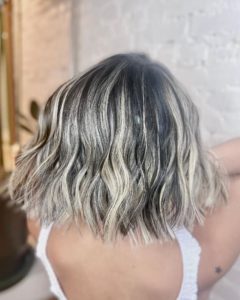


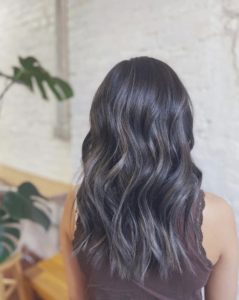
3 - Blonde Balayage
Blonde balayage can add dimension and texture to the hair, giving it a more natural, multi-dimensional appearance. This can be particularly beneficial for those with fine or thin hair, as it can help create the illusion of fuller, more voluminous hair.Blonde balayage can also brighten the face and create a more youthful appearance. The highlights can be strategically placed around the face to draw attention to certain features and create a more flattering look.

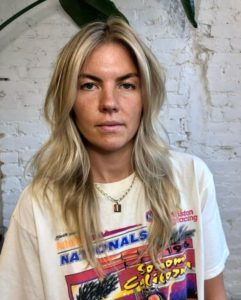
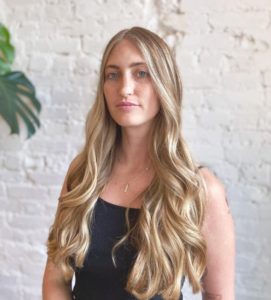
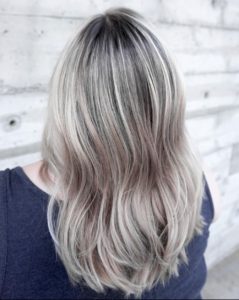
4 - Grey Pearl Balayage
Grey pearl balayage is a hair color trend that involves blending shades of grey and silver into the hair using the balayage technique. The color can range from soft, subtle grey highlights to a bolder, more dramatic silver color. Grey Pearl Balayage creates a unique, edgy, and sophisticated look. It can also help to brighten up the hair and complement different skin tones.However, grey and silver hair colors require more careful maintenance and regular toning to avoid yellowing or brassiness.
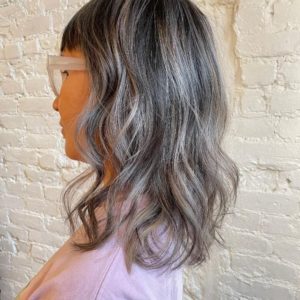
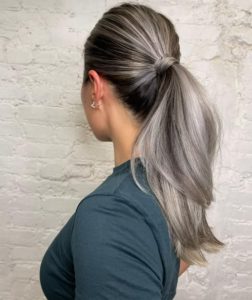
5 - Caramel Balayage
Caramel balayage is a popular hair coloring technique that involves the use of caramel-toned highlights to add dimension and warmth to the hair. The caramel highlights can range from subtle and natural-looking to bold and dramatic, depending on the client's preference. The highlights may be blended seamlessly into the natural hair color or applied in a more contrasting, noticeable pattern.Caramel balayage can work well on a variety of hair colors, including brunettes, blondes, and redheads. It can also be customized to suit a wide range of skin tones, from cool to warm.

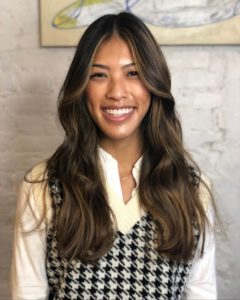
6 - Chestnut Balayage
The chestnut color typically has a range of warm brown tones, including reddish-brown and chocolate-brown shades. Chestnut balayage can work well on a variety of hair colors, including brown, blonde, and red hair.One of the benefits of chestnut balayage is that it can add warmth and depth to the hair, creating a natural-looking glow. It can also help to bring out the natural beauty of the hair and complement different skin tones.
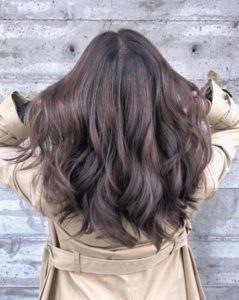
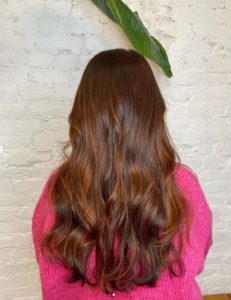
7 - Lavender Balayage
Lavender balayage is a trendy hair color that involves blending lavender or purple tones into the hair using the balayage technique. The color can range from subtle lavender highlights to a bold, vibrant purple color. Lavender Balayage can be a fun and playful option for those looking to experiment with a unique hair color.Lavender balayage gives a pop of color and dimension to the hair, creating a unique and eye-catching look. It can also help to brighten up the hair and complement different skin tones.
However, it's important to note that vivid and pastel hair colors require more careful maintenance and regular touch-ups to maintain the vibrancy of the color.
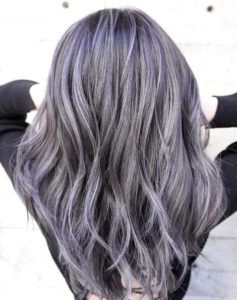
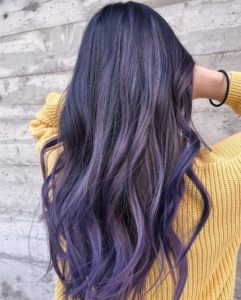
8 - Pink Balayage
Pink Balayage has been a popular hair color trend for several years. Many people love the unique and playful look that pink balayage can create, and it has become a go-to option for those looking to add some fun and vibrancy to their hair. Pink Balayage can be customized to suit a range of skin tones and hair types and can be applied in a subtle or bold way depending on the individual’s preference. This versatility has contributed to its popularity and made it a favorite among those who want to experiment with hair color.Just as same as the lavender color, it requires more careful maintenance and regular touch-ups to maintain the vibrancy of the color.

5: Q&A
Q: What is the difference between Highlights vs Balayage?
A: Highlights and balayage are both hair coloring techniques that are used to create dimension and depth in the hair. However, there are some key differences between the two:Placement: The placement of highlights and balayage is different. With highlights, the color is typically placed evenly throughout the hair, often starting at the roots and extending to the ends. With balayage, the color is applied more selectively, with the focus being on creating a natural, sun-kissed effect that mimics the way hair would naturally lighten in the sun.
Result: The final result of highlights and balayage can also differ. Highlights tend to create a more dramatic contrast between the lightened sections and the natural hair color, while balayage creates a softer, more natural-looking effect.
Maintenance: Balayage typically requires less maintenance than highlights, as the grow-out is more gradual and the color is applied in a way that allows it to blend more seamlessly with the natural hair color. Highlights may require touch-ups more frequently to maintain the desired level of contrast between the lightened sections and the natural hair color.

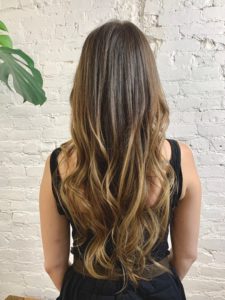
Comparison of Highlight vs Balayage
Q: How should I style my Balayage hair? Should I curl my Balayage hair?
A: Balayage hair can look great when it is curled, as the highlights and lowlights can create a beautiful dimensional effect that enhances the texture and movement of the curls. We usually style with curls for customers at the salon and recommend our clients curling if they want to enjoy the maximized dimensional effects.However, whether or not you curl your Balayage hair depends on your personal preference and hair type. Some people may find that their balayage looks best when styled with curls or waves, while others may prefer a straighter look. It's important to experiment with different styling techniques to find the look that works best for you and your hair. (If you curl your hair, please make sure to curl with a lower heat setting and use heat-protectant products to minimize damage to your hair!)
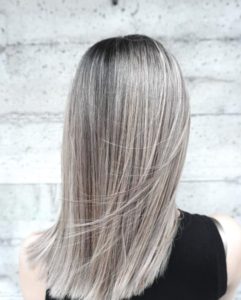

Q: How often do I need to go to a hair salon for maintenance?
A: The frequency of salon visits for maintaining your balayage can vary depending on several factors, such as your natural hair color, the extent of your highlights, and your hair growth rate. In general, however, you can expect to need touch-up appointments every 8 to 12 weeks. At Three Degrees Salon, we have a Highlights/Balayage Touch Up menus for people who had colored within 3 months.If you have a subtle balayage, you may be able to wait longer between appointments, while a more dramatic balayage may require more frequent touch-ups to keep the highlights looking fresh and vibrant.
The best way to figure this out is to work with your stylist/colorist to develop a maintenance plan that works for your hair type and lifestyle. They can guide the best hair care routine to keep your hair healthy and vibrant between appointments, and recommend products to help maintain your color and prevent damage. With proper care and maintenance, your balayage can look great for months at a time!
Q: My hair tends to start getting brassy a few months after coloring. Is this because of the color fading? What are the tips to preserve hair colors?
A: Hair can sometimes look brassy after coloring, particularly if the hair has been lightened or if the color used has warm undertones. Brassiness occurs when the warm undertones in the hair become more pronounced, creating an orange or yellow cast. This can happen due to a variety of factors, including exposure to sunlight, minerals in the water, and the natural pigments in the hair.Color fading can contribute to brassiness, but it is not always the primary cause. Over time, the color can become less vibrant, allowing the underlying warm tones to show through more prominently.
We have written another article about tips to minimize bleached hair damage and preserve hair color. Please check out the below post and follow the tips if you want to sustain your beautiful Balayage look! Also, if you have a personal concern about your hair, consulting with your stylist/colorist is always a good idea.
6 Tips to Minimize Bleached Hair Damage and Preserve Hair Color
2: Summary
As explained, Balayage would be a good coloring option for a wide range of hair types, textures, and colors, but it is particularly suitable for those who want a low-maintenance, natural-looking hair color that adds dimension and depth to their hair without going for a full head of highlights.There are various coloring techniques explained in this post but you don’t need to remember all – but make sure to bring some style images that you want to be to the appointment and show them to your colorist/stylists. Then they can help you determine the best color and technique to suit your hair type, skin tone, and desired look.
Three Degrees Salon has skillful colorists/stylists who are great at coloring, so please go online to book an appointment if you would like to get Balalyage from us!
We also welcome complimentary online consultations for anyone who would like to get their hair done by us but have any questions/concerns that need to be addressed before the appointment. Please contact us by following our consultation guidelines at the link below.
Hope this blog post helps you learn about Balayage and gives you some inspirations 🙂
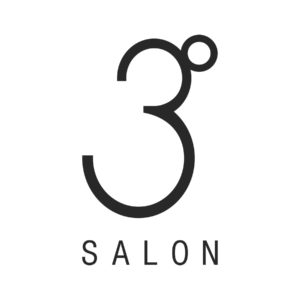
Three Degrees Salon
204 E6th Street New York NY 10003 Instagram @Threedegreessalon OTHER POPULAR POSTS: The Essential Guide to Digital Perm & Hottest 7 Styles for Every Length 32 Stunning Permed Hair Style : Short to Super Long Hair Color Guide - Read if you are unsure which menu to book